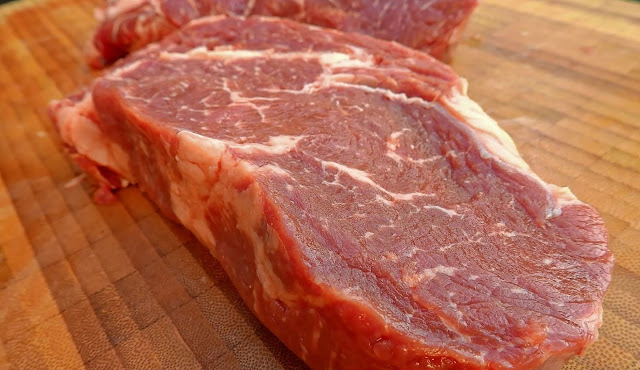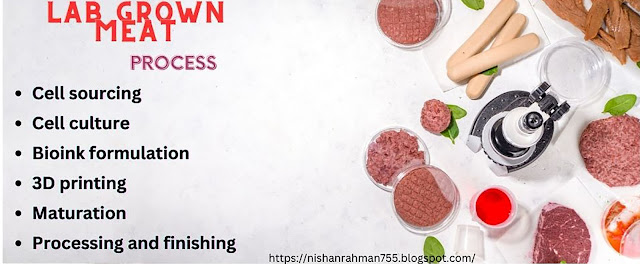3D Printed Meat: Brilliant Future of Food
 |
3D printed meats, often called cultured or lab-grown meats, are three-dimensional objects made of living cells. In 2013, London's first lab-grown burger made attention. Companies are using this technology to produce a sustainable and ethical meat alternative.
TABLE OF CONTENTS
The
History of 3D Printed Meat
Advantages
of 3D Printed Meats
Disadvantages
of 3D Printed Meats
Cost
Considerations of 3D Printed Meats
3D
Printed Meats in the Restaurant Industry
The
Future of 3D Printed Meats
Ethical
and Sustainability Considerations of 3D Printed Meats
The History of 3D Printed Meat
The idea of 3D printed meats can be traced back to the early
2000s when NASA funded research to find a way to produce food for astronauts on
long space missions. The aim was to create a technology that could use a small
amount of animal cells to produce a large amount of meat, thereby reducing the
need for live animals and the resources required to raise them.
In 2003, a patent was filed for the first 3D printed meat
product, which was created using a process called bio-printing. This involved
using a 3D printer to layer cells on top of each other until they formed a
solid structure. However, it was not until a decade later that the technology
had advanced enough to produce a viable product.
In 2013, Dutch scientist Mark Post unveiled the world's
first lab-grown burger, which was made using muscle cells taken from a cow. The
burger, which cost around $300,000 to produce, was cooked and tasted by a panel
of food critics in London. While the taste was reportedly not as good as a
traditional burger, it was seen as a major step forward in developing this
technology.
How 3D Printed Meats are Made
3D printed meats are made using a process that involves
several steps:
- Cell sourcing: For lab-grown or cultured meats, a small sample of animal cells is collected from a living animal through a biopsy or other methods. These cells can be muscle cells, fat cells, or other types of cells that contribute to the composition of meat.
- Cell culture: The collected cells are placed in a controlled environment, typically in a culture medium that provides the necessary nutrients for their growth. The cells multiply and form larger populations.
- Bioink formulation: A bioink, which is a mixture of cells and other supporting materials such as scaffolds, proteins, and growth factors, is prepared. The bioink provides the necessary structure and organization for the 3D printing process.
- 3D printing: Using a specialized 3D printer, the bioink is deposited layer by layer to create a three-dimensional structure. The printer follows a pre-determined design or pattern to build the desired shape of the meat product.
- Maturation: After the initial printing, the 3D-printed meat structure goes through a maturation process. This involves providing the necessary conditions, such as temperature and nutrients, to allow the cells to develop and differentiate into muscle tissue, creating a more meat-like texture.
- Processing and finishing: The 3D-printed meat may undergo additional processing steps, such as cooking, seasoning, and texturizing, to enhance its taste and sensory properties and make it ready for consumption.
Advantages of 3D Printed Meats
3D-printed meats have many benefits.
- They use less water, land, and feed than traditional meat production. Because lab-grown 3D-printed meats don't require animals.
- Since 3D-printed meats don't kill animals, they're more ethical.
- 3D-printed meats can be customized for fat, flavor, and texture.
Disadvantages of 3D Printed Meats
3D-printed meats have cons too.
- The technology is still developing, and it is unclear how it will scale up to meet global meat industry demands.
- 3D-printed meats are more expensive than traditional meat products because the technology is new and the production process is more complicated.
- 3D printed meats are new and nothing is known about their long-term health impacts, raising worries regarding their safety and regulation.
Types of 3D Printed Meats
- Plant-based meats: Some companies are utilizing 3D printing technology to create plant-based meat substitutes. These products are typically made from a combination of plant proteins, fats, and other ingredients.
- Cultured or lab-grown meats: 3D printing can be used as a technique to shape and structure lab-grown or cultured meats. Cultured meats are produced by growing animal cells in a lab and then combining and layering them using a 3D printer to create meat-like structures.
- Hybrid meats: In some cases, 3D-printed meats can be a combination of plant-based and cultured meat components. This approach aims to create products that mimic the taste, texture, and appearance of conventional meats while incorporating sustainable and ethical production methods.
Several types of 3D-printed meats, including beef, chicken,
pork, and vegan options, are presently in development. Each form of meat has
its own distinct characteristics, and its production involves distinct
techniques and processes.
Beef is one of the most popular 3D-printed meats because it
is the most widely consumed meat worldwide.
As an everyday food in many parts of the world, chicken is
another popular type of 3D-printed meat.
In addition to beef, pork is in high demand worldwide, and a
number of companies are developing 3D-printed pork products.
Top 3D Printed Meat Companies
There are several companies that are currently leading the
way in 3D printed meat production. These include Redefine Meat, Beyond Meat,
and Aleph Farms.
- Beyond Meat is a prominent plant-based meat company founded in 2009.
- The company's headquarters are located in El Segundo, California, USA.
- Beyond Meat has gained significant popularity and is available in numerous retail and foodservice outlets worldwide.
- Aleph Farms is a food technology company specializing in cultivated meat products.
- Founded in 2017, Aleph Farms is headquartered in Rehovot, Israel.
- The company focuses on developing cultivated beef that closely resembles conventional beef in taste, texture, and nutrition.
- Cultivated meat, also known as lab-grown or cell-based meat, is produced by culturing animal cells in a lab.
- Memphis Meats is a food technology company focused on the development of cultured meat.
- The company was founded in 2015 and is based in Berkeley, California, USA.
- Memphis Meats aims to create sustainable and cruelty-free alternatives to traditional animal agriculture.
- The company has focused on cultivating beef, chicken, and duck meat.
- MeaTech is a food technology company specializing in cultured meat production.
- Founded in 2018, headquartered in Israel.
- They focus on developing lab-grown meat products as a sustainable and ethical alternative to traditional meat.
- Meatable is a food technology company focused on cultured meat production.
- Founded in 2018, headquartered in Leiden, the Netherlands.
- They utilize proprietary technologies, including their OptiOxTM platform, to produce high-quality, scalable, and sustainable meat products.
- Nova Meat is a food technology company specializing in plant-based and 3D-printed meat alternatives.
- The company was founded in 2018 in Barcelona, Spain.
- Nova Meat is at the forefront of innovation in the plant-based meat industry.
- Redefine Meat, based in Israel, is focused on creating 3D printed plant-based meat substitutes with a realistic texture and taste.
Cost Considerations of 3D Printed Meats
One of the main challenges facing 3D printed meat production
is the cost of the technology.
Currently, 3D printed meats are more expensive than
traditional meat products, as the technology is still in its infancy and the
production process is more complex.
However, as the technology develops and becomes more
mainstream, it is expected that the cost of 3D printed meats will decrease.
This could make them a more viable option for consumers who
are looking for sustainable and ethical alternatives to traditional meat.
3D Printed Meats in the Restaurant Industry
The restaurant industry is one of the key areas where 3D
printed meats are expected to make an impact. Several companies, including KFC,
have already started to experiment with 3D printed meat products.
In 2020, KFC announced that it had partnered with a Russian company called 3D Bioprinting Solutions to develop 3D printed chicken nuggets. The nuggets were made using a combination of chicken cells and plant-based materials, and were designed to be "as close as possible in both taste and appearance to KFC's original chicken nuggets".
View Top Picks in Meat Items! Links Here!
The Future of 3D Printed Meats
Many experts think that 3D printed meat will change the way
we make and eat meat.
As the technology gets better and more people use it, the
price of 3D-printed meats is likely to go down, making them a more affordable
choice for consumers.
There are also some ethical and environmental benefits to
3D-printed meats that could make them appealing to people who care about animal
health and the environment.
But there are still a lot of problems that need to be solved
before 3D-printed meals can be widely used.
Ethical and Sustainability Considerations of 3D
Printed Meats
When it comes to 3D printed meats, there are a number of
ethical and environmental factors that need to be taken into mind.
One of the primary advantages of this technology is that it
has the potential to decrease the number of animals that need to be slaughtered
for the production of meat, which in turn will lessen the negative impact that
traditional meat production has on the environment.
However, there are also questions regarding the long-term
consequences that 3D printed meats will have on human health, in addition to
the safety of this technology and the regulations that will govern it.
Before 3D printed meats may become a widespread food product, it is essential for these concerns to be resolved.
Frequently Asked Questions
Is 3D PRINTED MEAT HALAL?
3D-printed beef may be halal.
Meat must be slaughtered according to Islamic dietary
regulations to be halal.
3D-printed meat may be halal if the cells used for culturing
are from halal animals slaughtered according to Islamic law and the production
procedure is halal.
However, Islamic authorities or certification agencies must
evaluate the full supply chain, including sourcing, processing, and production
procedures, to certify 3D-printed meat as halal.
Is 3D PRINTED MEAT EXPENSIVE?
As of now, 3D printed meat is generally expensive due to the
complex and resource-intensive production process.
However, as technology advances and economies of scale are
achieved, it is expected that the cost will decrease, making it more accessible
and affordable for consumers in the future.
Conclusion
In conclusion, 3D printed meats are a fascinating new
technology that has the potential to revolutionize the way we produce and
consume meat. While there are still many challenges that need to be overcome
before this technology can become a mainstream food product, there are also
many benefits to 3D printed meats, including their sustainability, ethical
considerations, and potential for innovation in the restaurant industry.
As we continue to explore the fascinating world of 3D
printed meats, it is important that we consider both the advantages and
disadvantages of this technology, and work to address any concerns that arise
along the way. Only then can we truly harness the potential of this innovative
new technology and create a more sustainable and ethical future for food
production.









Post a Comment